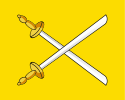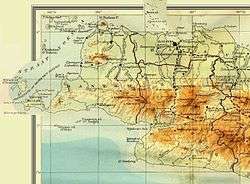Banten Sultanate
| Sultanate of Banten | ||||||||||||||
| Kasultanan Banten | ||||||||||||||
| ||||||||||||||
 Flag
 Coat of arms
| ||||||||||||||
 Rough extent of Banten at the death of Hasanudin, controlling both sides of Sunda Strait | ||||||||||||||
| Capital | Old Banten, Serang | |||||||||||||
| Languages | Sundanese, Banten, Javanese, Lampung | |||||||||||||
| Religion | Islam | |||||||||||||
| Government | Sultanate | |||||||||||||
| Sultan | ||||||||||||||
| • | 1552–1570 ¹ | Sultan Maulana Hasanuddin | ||||||||||||
| • | 1651–1683 | Sultan Ageng Tirtayasa | ||||||||||||
| • | 1809–1813 | Sultan Maulana Muhammad Shafiuddin | ||||||||||||
| • | 2016–now | Sultan Syarif Muhammad ash-Shafiuddin | ||||||||||||
| History | ||||||||||||||
| • | invasion of kingdom of Sunda | 1527 | ||||||||||||
| • | annexation by Dutch East Indies | 1813 | ||||||||||||
| ||||||||||||||
| Today part of | | |||||||||||||
| ¹ (1527–1552 as a province under Sultanate of Cirebon) | ||||||||||||||
The Banten Sultanate was founded in the 16th century and centred in Banten, a port city on the northwest coast of Java; the contemporary English spelling of both was Bantam. It is said to have been founded by Sunan Gunungjati, who had previously founded Cirebon.
Once a great trading centre in Southeast Asia, especially of pepper, its importance was overshadowed by Batavia, and finally annexed to Dutch East Indies in 1813. Its core territory now forms the Indonesian province of Banten. Today, in Old Banten, the Grand Mosque of Banten is an important destination for tourists and for pilgrims from across Indonesia and from overseas.[1]
Formation
Before 1526 CE, a settlement called Banten was situated about ten kilometres inland from the coast on the Cibanten River, in the area which is today occupied by the southern suburbs of the town of Serang. It was known as Banten Girang, meaning "Banten-up-the-river" owing to its location.[2]
Sunan Gunungjati (Sharif Hidayatullah) was an "ulama", an educated class of Muslim legal scholars. He was educated in Middle East, and can trace his ancestry to the Kingdom of Sunda. Sharif Hidayatullah become the Sultan of Cirebon in 1479. In 1482 Sharif Hidayatullah sent a letter to King of Sunda, proclaiming Cirebon independent from Sunda Pajajaran. Previously Cirebon settlement was founded in 1445 by his uncle Prince Cakrabuana.[3] In the early 16th century, Gunungjati arrived in the town with the intention of spreading the word of Islam in this still-Hindu area.
According to Suma Oriental, written in 1512–1515, Tomé Pires, a Portuguese explorer reported that the port of Banten still belonged to the Kingdom of Sunda, while Cirebon had been established as an Islamic state.
Suma Oriental.[4]
Although at first well received by Sunda authorities, after news of the Portuguese-Sunda alliance in 1522 became known, Gunungjati nevertheless asked Demak sultanate to send troops to Banten. It was likely his son, Hasanudin, who commanded this military operation in 1527, just as the Portuguese fleet was arriving of the coast at Sunda Kelapa, to capture these towns.[5]
Sunan Gunungjati crowned Hasanudin king of Banten by the Sultan of Demak who, in turn, offered Hasanudin his sister’s hand in marriage. Thus, a new dynasty was born at the same time as a new kingdom was created. Banten was the capital of this kingdom, held as a province under Sultanate of Cirebon.[6]
Growth

From the beginning it was obviously Hasanuddin’s intention to revive the fortunes of the ancient kingdom of Sunda for his own benefit. One of his earliest decision was to travel to southern Sumatra, which had traditionally belonged to the kingdom of Sunda, and from which the bulk of the pepper sold in the Sundanese region came. He was keen to assure himself of the loyalty of these wealthy areas as soon as possible and to guarantee supplies of pepper for his ports, since it was on this spice that all international trade was based and, hence, in which the wealth of his kingdom lay.[8]
Having established control over the ports and the pepper trade, Hasanuddin decided to build a new capital, to symbolise the new era which was beginning. On the advice of his father, Sunan Gunungjati, he choose to construct it on the coast at the mouth of the Cibanten River. That a settlement already existed at this place is evidence by its harbour activities, but at this time the seat of political power was in Banten Girang. The royal city was founded on the delta, formed by the two arms of the river. Two main streets running north-south and east-west divided the city into quarters. The royal palace surrounded by residences of the principal minister of state, was built on the south side of the royal square and the great mosque on the west side. Foreigners, for the most part merchants, had to live outside the royal city, that is on either side of the delta.
After some twenty years the new dynasty was so firmly established that Hasanuddin had no hesitation in leaving the kingdom in 1546 to take part in a military expedition against Pasuruan in eastern Java, at the request of Sultan Trenggana, third sultan of Demak. The Sultan lost his life in this venture, and it is likely that Hasanuddin took advantage of his suzerain’s death and the troubles which ensued to free his kingdom from any further obligations to this royal house.
From the 1550s onwards the kingdom enjoyed a period of great prosperity. According to tradition, the development of this kingdom was managed by Hasanuddin’s son, Maulana Yusuf, who had become co-sovereign with his father, following a custom long practised in the archipelago.[9]

.
Also during this period, Hasanuddin decided to launch the final blow to what remained of the kingdom of Sunda. Maulana Yusuf led the attack on Dayeuh Pakuan, its capital city located in modern Bogor. After losing its most important port Sunda Kelapa, the kingdom, already deprived of its trading revenues, was of symbolic importance only. The kingdom put up little resistance and henceforth Banten ruled over the entire territory of the former kingdom of Sunda, which corresponds to most of current Indonesian province of West Java.
The sacred stone (watu gigilang) that was serving as the sovereign’s throne of Sunda kingdom was taken away and put at the street intersection in the royal square of Banten, thus marking the end of the Sundanese dynasty. Henceforth, this stone was to serve as the Banten sovereign’s throne.
When Hasanuddin died in 1570, the royal kingdom of Banten comprised all of Sunda, except for Cirebon, and all of southern Sumatra, as far as Tulangbawang (modern-day Lampung) in the northeast and Bengkulu in the northwest. Trade was expanding to become one of the largest in Southeast Asia.[10]
Traders coming from China, India, Turkey, England, Portugal and the Netherlands were frequent visitors to the Banten harbour. Spices, silk, Chinese ceramics, gold, jewellery and other Asian goods attracted European merchants. Banten was a pioneer in international trade. Banten was also known as an educational centre for Islamic studies.[11] Among Islamic scholars in Banten was Sheikh Yusuf. He was a scholar from Makassar who worked under Sultan Ageng Tirtayasa.
During his reign Banten and Mataram Sultanate involved in rivalry to dominate the region, while Cirebon stuck in the middle. Although Cirebon had never attacked by Mataram, since 1619 Cirebon has been practically held under Mataram influences and behaves as vassal. In 1650 Mataram asked Cirebon to urge Banten to subscribe under Mataram domination. Banten refuse the threat, and in response Mataram ordered Cirebon to attack Banten. In 1650 Cirebon sent 60 ships to attack Banten port in Tanahara. However, this naval campaign ended in disastrous defeat of Cirebon. This war is known as Pagarage war or Pacirebonan war that took place in 1650.
In 1661 Sultan Ageng Tirtayasa extended Banten's rule to Landak in western Borneo. On the other hand, Cirebon relations with Mataram were also strained. The tension culminated with the execution of Cirebon king Panembahan Girilaya in Plered, while the Cirebon Princes were taken as the hostage in Mataram. Prince Wangsakerta of Cirebon went to Banten to seek Sultan Ageng Tirtayasa help to free his brothers. Sultan Ageng Tirtayasa is the son of Prince Abu Maali that died in Pagarage war. Tirtayasa agreed to assist Cirebon and saw it as an opportunity to raise Banten's influence upon Cirebon. Using the opportunity of Trunojoyo rebellion against Mataram, Sultan Ageng Tirtayasa secretly supported the revolt and managed to weaken Mataram and safe the two Cirebon princes.
However, Sultan Ageng Tirtayasa saw an opportunity to impose Banten's influence upon Cirebon. He crowned both princes he saved as the sultans, Prince Mertawijaya as Sultan Kasepuhan while Prince Kertawijaya as Sultan Kanoman. By doing so the Sultan of Banten disintegrated and weakened the Sultanate of Cirebon into several petty states. On the other hand, Prince Wangsakerta that had fought for 10 years was only given a small title and estate. The cunning divide strategy was meant to weaken Cirebon and to prevent Cirebon to be Mataram ally and become a menace to Banten in the future as it had done in Pagarage war. In the 1670s he practically acquired Cirebon area as vassal following a civil war in Mataram. Ageng established trade with the Spanish Manila for silver and built canals for coconut palm and sugar plantations, among other developments.[12]
Western contacts

On 27 June 1596 Dutch trade ships led by Cornelis de Houtman, the first Dutch fleet to arrive in East Indies, landed in Banten. On its return to the Netherlands, the voyage (1595–97) generated a modest profit.[13] The Portuguese and Dutch fought for control of Banten in the 17th century. In 1600 the Dutch set up the Dutch East Indies Company.
Other Europeans were soon to follow. The English, who started to sail to the East Indies from around 1600, established a permanent trading post in Banten in 1602 under James Lancaster. In 1603, the first permanent Dutch trading post in Indonesia was established in Banten.[14]
Danish merchants also arrived from Tranquebar, in search of pepper. The trade relation is evident in two letters written by Sultan Ageng Tirtayasa to Frederick III of Denmark. [15]
Attesting to Bantem's renown in Europe is Henry Fielding's play "The Author's Farce" at whose conclusion the protagonist's problems are neatly solved when he is suddenly informed that he is "The Prince of Bantam", and that as the old "King of Bantam" has died he is to inherit the throne. Fielding and his London audience clearly conceived of "Bantam" as a prosperous country of which it was a great fortune to become the monarch.
Decline

After conflict with the Dutch over the pepper trade in 1619, the Dutch East India Company Governor-General Jan Pieterszoon Coen took the port of Jayakarta from Banten. He founded Batavia (now Jakarta) on the ruins of this Javanese town, which became the centre of VOC operation and a serious rival for Banten, later contributing to its decline. During the middle of 17th century several conflicts between Banten and the Dutch in Batavia, just 60 miles separated along the northern coast of Java, occurred.
In 1628–1629 Mataram Sultanate was involved in power contest with Dutch East India Company (VOC) and launched sieges on Batavia. Later Mataram was gradually weakened through struggle of successions of Javanese princes and Dutch involvements in internal Mataram court affair.
At Banten, meanwhile, Palace disputes erupted between Sultan Ageng Tirtayasa and his son and co-sovereign Sultan Haji. Sultan Ageng wished to maintain a policy of free-trade with all European powers, but his son wanted close relations with the Dutch in Batavia. Ageng's independence is shown in the letter to the Danish king mentioned above, offering to trade pepper from Banten for firearms and gunpowder.
With Sultan Haji allied with the VOC, a war broke between Batavia and Banten in the 1670s and 1680s. The result was disastrous for Banten: the VOC gained Bogor and Priangan Highlands (now West Java) and reduced Banten's power substantially, making it a protectorate of the VOC. Although nominally independent, its power was gone.
In 1752, the Dutch annexed territories on western Borneo and southern Sumatra formerly held by Banten.
In 1808 Herman Willem Daendels, Governor-General of the Dutch East Indies in 1808–1810, commissioned the construction of Great Post Road to defend Java from incoming British invasion. Daendels ordered Sultan Aliyuddin II of Banten to move the capital to Anyer and to provide labour to build a new port planned to be built at Ujung Kulon. The Sultan refused Daendels' command, and in response Daendels ordered the invasion of Banten and destruction of Surosowan palace. The Sultan, together with his family, was arrested in Puri Intan and held as a prisoner in Fort Speelwijk, and later sent into exile in Ambon.
On 22 November 1808, Daendels declared from his headquarters in Serang that the Sultanate of Banten had been absorbed into the territory of the Dutch East Indies.[16] In 1813 the Banten Sultanate ceased to exist when Thomas Stamford Raffles forced Sultan Muhamad Syafiuddin to give up his throne.[17] This was the final blow that marked the end of Sultanate of Banten.
List of Sultans of Banten
- Syarif Hidayatullah or Sunan Gunung Jati from Sultanate of Cirebon
- Sultan Maulana Hasanuddin or Prince Sabakinking 1552 - 1570[18]
- Sultan Maulana Yusuf or Prince Pasareyan 1570 - 1585
- Sultan Maulana Muhammad or Prince Sedangrana 1585 - 1596
- Sultan Abu al-Mafakhir Mahmud Abdulkadir atau Pangeran Ratu 1596 - 1647
- Sultan Abu al-Ma'ali Ahmad 1647 - 1651
- Sultan Abu al-Fath Abdul Fattah or Sultan Ageng Tirtayasa 1651-1683
- Sultan Abu Nashar Abdul Qahar or Sultan Haji 1683 - 1687
- Sultan Abu Fadhl Muhammad Yahya 1687 - 1690
- Sultan Abu al-Mahasin Muhammad Zainul Abidin 1690 - 1733
- Sultan Abu al-Fathi Muhammad Syifa Zainul Arifin 1733 - 1750
- Sultan Abu al-Ma'ali Muhammad Wasi Zainal Alimin atau Pangeran Arya Adisantika 1752 - 1753
- Sultan Arif Zainul Asyiqin al-Qadiri 1753 - 1773
- Sultan Abu al-Mafakhir Muhammad Aliuddin 1773 - 1799
- Sultan Abu al-Fath Muhammad Muhyiddin Zainussalihin 1799 - 1801
- Sultan Abu al-Nashar Muhammad Ishaq Zainulmutaqin 1801 - 1802
- Caretaker Sultan Wakil Pangeran Natawijaya 1802 - 1803
- Sultan Abu al-Mafakhir Muhammad Aliyuddin II 1803 - 1808
- Caretaker Sultan Wakil Pangeran Suramenggala 1808 - 1809
- Sultan Muhammad ibn Muhammad Muhyiddin Zainussalihin 1809 - 1813
- Sultan Syarif Muhammad ash-Shafiuddin or Ratu Bagus Hendra Bambang Wisanggeni Soerjaatmadja 2016 - now[21]
See also
Footnotes
- ↑ Multa Fidrus, 'Historic Grand Mosque to get new look', The Jakarta Post, 20 April 2013.
- ↑ Guillot, Claude (1990). The Sultanate of Banten. Gramedia Book Publishing Division. p. 12.
- ↑ "Sejarah Kabupaten Cirebon" (in Indonesian). Cirebon Regency. Retrieved 16 January 2013.
- ↑ Pires, Tome (1990) [1512–1515]. "The Suma Oriental of Tome Pires: An Account of the East, from Red Sea to China". Armando Cortesão. New Delhi: Asian Educational Services. p. 166. ISBN 81-206-0535-7. Retrieved 16 January 2013.
- ↑ Guillot, Claude (1990). The Sultanate of Banten. Gramedia Book Publishing Division. p. 17.
- ↑ Guillot, Claude (1990). The Sultanate of Banten. Gramedia Book Publishing Division. p. 18.
- ↑ From Valentijn, Beschrijving van Groot Djava, ofte Java Major, Amsterdam, 1796. Ludwig Bachhofer, India Antiqua (1947:280) notes that Valentijn had been in Banten in 1694.
- ↑ Guillot, Claude (1990). The Sultanate of Banten. Gramedia Book Publishing Division. p. 19.
- ↑ Guillot, Claude (1990). The Sultanate of Banten. Gramedia Book Publishing Division. p. 20.
- ↑ Guillot, Claude (1990). The Sultanate of Banten. Gramedia Book Publishing Division. p. 21.
- ↑ "Banten abounds in archeological treasures". The Jakarta Post. Jakarta. 7 October 1999. Archived from the original on 14 July 2009. Retrieved 3 January 2010.
- ↑ Ring, Trudy (1996). International Dictionary of Historic Places: Asia and Oceania. Braun-Brunfield. pp. 101–104. ISBN 1-884964-04-4.
- ↑ Ames, Glenn J. (2008). The Globe Encompassed: The Age of European Discovery, 1500–1700. pp. 97–99.
- ↑ Ricklefs, M.C. (1991). A History of Modern Indonesia Since c.1300, 2nd edition. London: MacMillan, p.29
- ↑ Gallop, Annabel (November 2003). "Seventeenth-century Indonesian letters in the public record office". Indonesia and the Malay World. 31 (91): 412–439. doi:10.1080/1363981042000188673.
- ↑ Ekspedisi Anjer-Panaroekan, Laporan Jurnalistik Kompas. Penerbit Buku Kompas, PT Kompas Media Nusantara, Jakarta Indonesia. November 2008. pp. 1–2. ISBN 978-979-709-391-4.
- ↑ Memimpikan Takhta Kesultanan Banten. Harian Kompas, Senin, 22 December 2003.
- ↑ "Sultan Maulana Hasanuddin, Sultan Banten Pertama". www.geni.com.
- ↑ "Sejarah Kesultanan Banten". kesultananbanten.weebly.com.
- ↑ "Ratu Syarifah Fatimah". timikasatu.com.
- ↑ "Pewaris Kesultanan Banten Terima Mandat". bantenraya.com.
References
- Sumber-sumber asli sejarah Jakarta, Jilid I: Dokumen-dokumen sejarah Jakarta sampai dengan akhir abad ke-16
- The Sunda Kingdom of West Java From Tarumanagara to Pakuan Pajajaran with the Royal Center of Bogor, Herwig Zahorka, Yayasan Cipta Loka Caraka, Jakarta, 2007-05-20
| Wikimedia Commons has media related to Banten Sultanate. |


